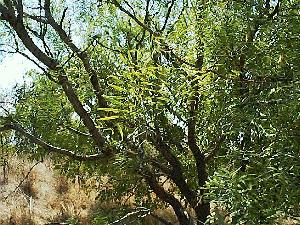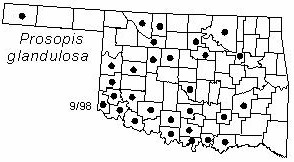
Large shrub or small tree to 6 m (20 ft) tall and 30 cm (1 ft) in diameter. Bark rough, thick, brown, divided into long narrow strips. Twigs glabrous, brown, with usually paired (stipular) sharp spines at the nodes. Buds very small, no terminal bud. Leaves alternate, drooping, bipinnately compound with only one pair of side branches. Leaflets sessile, 7-17 pairs, narrowly oblong, 1-3 cm (0.4-1.2 in) long, yellowish-green, glabrous. Flowers very small, numerous, crowded in spikes about 5-7.5 cm (2-3 in) long, blooming in Spring and Summer. Fruits legumes, 10-20 cm (4-8 in) long and about 1 cm (0.4 in) in diameter, slightly constricted between seeds, yellowish or brown, ending in a sharp point, maturing in late Summer or Fall.
Distribution: Southwestern U. S. and northern Mexico.
Habitat: Plains and foothills in semiarid regions.
NWI status: FACU
Comment: There is disagreement about the presettlement range of the species. It is sometimes said that mesquite was confined to south Texas until the big cattle drives started after the Civil War, but there were a few large mesquite trees in the Ft. Sill area (Comanche County) in 1873. However, mesquite has apparently become much more abundant in that area since settlement. Aerial photographs made at Ft. Sill in 1945 and 1990 show that mesquite became more abundant and covers more area in the 45 years between the photographs. The map shown below represents the present range in Oklahoma. Prosopis is the old Greek name for the burdock; glandulosa refers to nectar glands in the flower.
Distribution in Oklahoma: 
BACK
NEXT
RETURN TO INDEX
Last update: 9/15/99
 Go to Oklahoma Biological Survey Home Page
Go to Oklahoma Biological Survey Home Page
 Disclaimer
Disclaimer